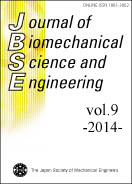Volume 9, Issue 1
Displaying 1-8 of 8 articles from this issue
- |<
- <
- 1
- >
- >|
Papers
-
2014Volume 9Issue 1 Pages JBSE0001
Published: 2014
Released on J-STAGE: January 28, 2014
Download PDF (1420K) -
 2014Volume 9Issue 1 Pages JBSE0002
2014Volume 9Issue 1 Pages JBSE0002
Published: 2014
Released on J-STAGE: February 07, 2014
-
2014Volume 9Issue 1 Pages JBSE0003
Published: 2014
Released on J-STAGE: March 03, 2014
Download PDF (1304K) -
2014Volume 9Issue 1 Pages JBSE0004
Published: 2014
Released on J-STAGE: March 10, 2014
Download PDF (2809K) -
2014Volume 9Issue 1 Pages JBSE0005
Published: 2014
Released on J-STAGE: March 11, 2014
Download PDF (480K) -
2014Volume 9Issue 1 Pages JBSE0006
Published: 2014
Released on J-STAGE: April 01, 2014
Download PDF (3424K) -
 2014Volume 9Issue 1 Pages JBSE0007
2014Volume 9Issue 1 Pages JBSE0007
Published: 2014
Released on J-STAGE: April 24, 2014
-
2014Volume 9Issue 1 Pages JBSE0008
Published: 2014
Released on J-STAGE: May 21, 2014
Download PDF (4111K)
- |<
- <
- 1
- >
- >|
